| Columns Retired Columns & Blogs |
Camelot Technology Uther v2.0 D/A processor Measurements
Sidebar 2: Measurements
All measurements were performed with the Uther powered by AC rather than by batteries. The balanced analog outputs measured as having a very low source impedance—just 3 ohms—except in the low bass, where this rose to a still low 27 ohms. By contrast, the single-ended outputs featured a slightly higher 13 ohms at mid and high frequencies, 20 ohms at 20Hz. The polarity was noninverting from both sets of outputs with the phase control set to normal. (The XLRs appeared to be wired with pin 2 "hot.") The output level with the volume control set to "100" or "Out" was a high 6.125V RMS from the balanced outputs, 3.06V from the unbalanced. (The latter is a very audible 3.5dB higher than the CD standard 2V, but is sufficient to fully drive 99.9% of the power amplifiers out there.) The analog volume-control steps appeared to be around 0.6dB/division; ie, every reduction in the numerical setting of "10" resulted in a 6dB drop in level.
The top traces in fig.1 show the Uther's frequency response. The output drops by 0.7dB or so at 20kHz, which may be just audible to younger listeners as a very slight softening. The channels match to within 0.05dB, which is excellent. The bottom traces are the left and right responses with pre-emphasized data—they match the top traces very closely, indicating accurate de-emphasis. Fig.2 shows the Uther's channel separation, which is also excellent, the crosstalk remaining below –100dB even at 10kHz.
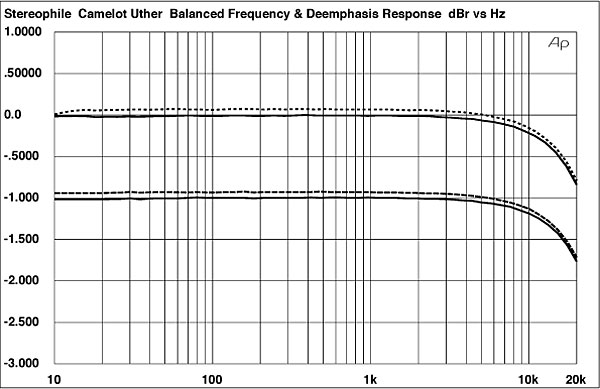
Fig.1 Camelot Uther v2.0, frequency response (right channel dashed, 0.5dB/vertical div.).
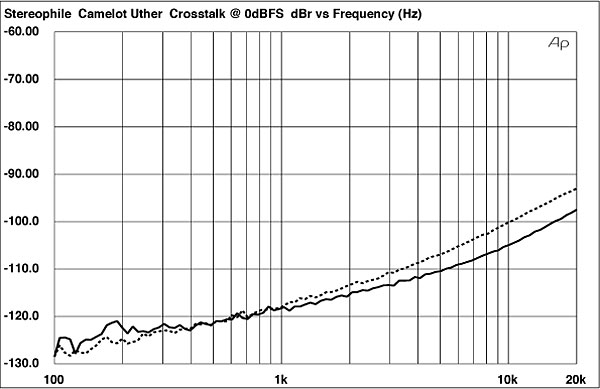
Fig.2 Camelot Uther v2.0, channel separation (L–R dashed, 10dB/vertical div.).
Fig.3 shows a spectral analysis of the Uther's output while it decoded data representing a dithered 1kHz tone at –90dB. The upper pair of traces is with the Audio Precision digital generator's word length set to 16 bits, the bottom with it set to 20 bits. The unit's dither was switched on for these measurements; it can be seen that the Uther's noise floor limits resolution to 16 bits below 300Hz or so, though the right channel is better than the left in this respect. In the treble, however, the longer word length gives a 5–6dB reduction in the level of the noise floor. Fig.4 shows similar spectral analyses with the Camelot reproducing digital silence, again with both 16-bit and 20-bit word lengths.
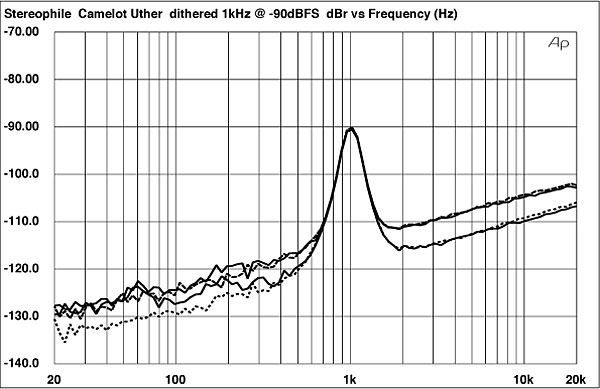
Fig.3 Camelot Uther v2.0, spectrum of dithered 1kHz tone at –90.31dBFS, with noise and spuriae: 16-bit data, top; 20-bit data, bottom (1/3-octave analysis, right channel dashed).
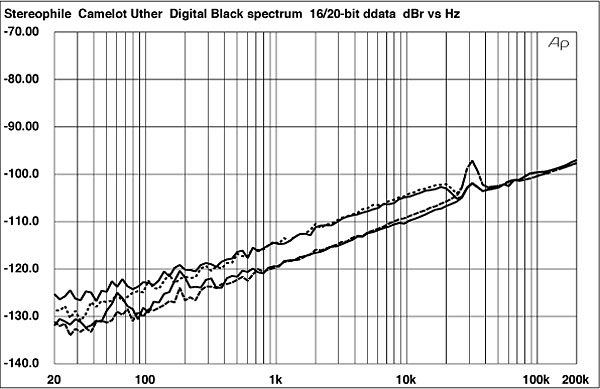
Fig.4 Camelot Uther v2.0, spectrum of digital silence, with noise and spuriae: 16-bit data, top; 20-bit data, bottom (1/3-octave analysis, right channel dashed).
Fig.3 implies low amplitude error; this is confirmed by fig.5, which shows the Camelot's linearity with 16-bit data. The output level tracks the data level very accurately down to below –80dBFS, with a still-negligible negative error down to –100dBFS. Looking at the waveform of an undithered 16-bit, 1kHz tone at –90.31dB (fig.6), however, revealed that, even with the Uther's dither turned off, the processor still appeared to be doing some waveshaping. (This waveform should be reproduced as a stepped wave switching between three distinct and equal levels—see the Audio Research review elsewhere in this issue for a good example.)
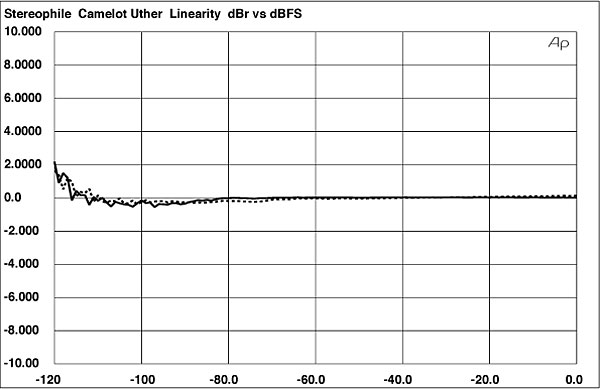
Fig.5 Camelot Uther v2.0, departure from linearity (2dB/vertical div., right channel dashed).
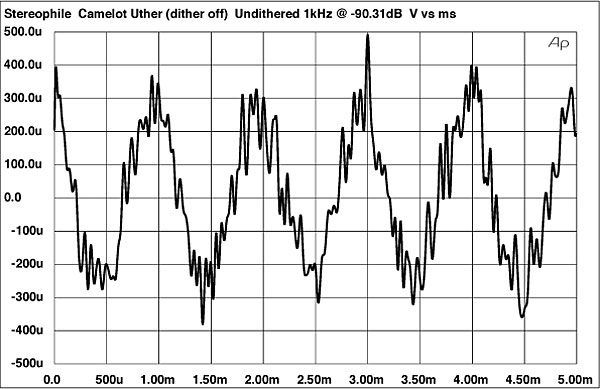
Fig.6 Camelot Uther v2.0, waveform of undithered 1kHz sinewave at –90.31dBFS (16-bit data).
The Uther's analog stages introduced a bit more intermodulation distortion than I would have expected. Driving the processor with an equal mix of 19kHz and 20kHz tones gave the spectrum shown in fig.7. Though the 1kHz difference component is conspicuous by its absence, the second-order tones at 18kHz and 21kHz lay at –66dB (0.05%), with other tones visible.
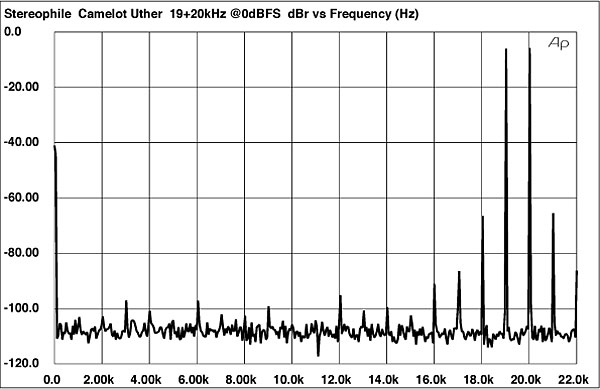
Fig.7 Camelot Uther v2.0, HF intermodulation spectrum, DC–22kHz, 19+20kHz at 0dBFS (linear frequency scale, 20dB/vertical div.).
To examine the Camelot's jitter performance, I drove it with data representing an 11kHz tone at –10dBFS while the LSB is toggled on and off at a 229Hz rate. (The test signal was played on a PS Audio Lambda transport, connected to the Uther via an Apature S/PDIF cable.) A Miller Audio Research analyzer was hooked up to the Camelot's left-channel analog output and performed a high-resolution, 32,768-point FFT analysis of its noise floor.
This spectrum is shown in fig.8, with the grayed-out spectrum of the Audio Research CD2 shown for comparison. The overall jitter level was a still very low 175.4 picoseconds (ps) peak–peak, compared with the CD2's 168.6ps. Interestingly, the Audio Research's central tone spreads somewhat compared with the Camelot's, which might indicate the presence of very-low-frequency jitter in the former's output. Note also that the fundamental 229Hz sideband is highest in level above the central tone for the Uther, whereas the Audio Research has the lower 229Hz sideband highest in level. I have no idea what this means.
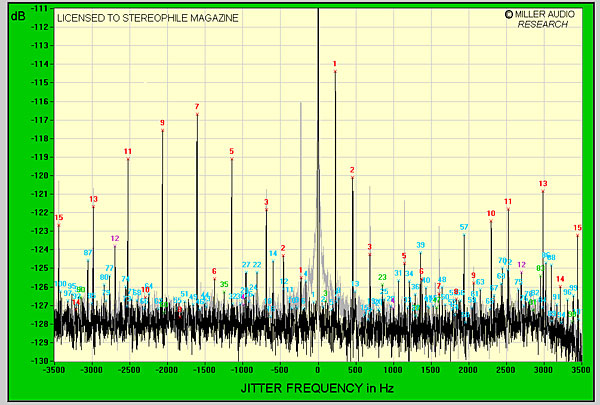
Fig.8 Camelot Uther v2.0, high-resolution jitter spectrum of analog output signal (11kHz at –10dBFS with LSB toggled at 229Hz). Center frequency of trace, 11kHz; frequency range, !X3.5kHz. Grayed-out spectrum is that of the Audio Research CD2.
The main jitter components that can be found in the Uther's analog noise floor, however, are the 229Hz–spaced data-induced components (indicated with red numbered markers), which presumably arise from the S/PDIF interface. It would seem a no-brainer, therefore, to hook up the Dragon Pro jitter reducer to the Uther via its I2S interface (two I2 cables are required to do this, as well as the Royal Bloodline comms link) to see if these sidebands would be reduced by the I2S connection.
Unfortunately, I couldn't get the Uther to put out an analog signal under these conditions. Everything was hooked up according to Camelot's informative manual, and the input switching, data-lock LEDs, and displays all appeared to be working correctly. But no matter what I did, no signal appeared at the unit's analog output jacks. Once I've figured out what was wrong, I will report on the measured effect of the Dragon Pro in a future issue.
Overall, the Uther measured very well on the test bench. But boy, it sure is one ugly piece of kit.—John Atkinson
- Log in or register to post comments




































